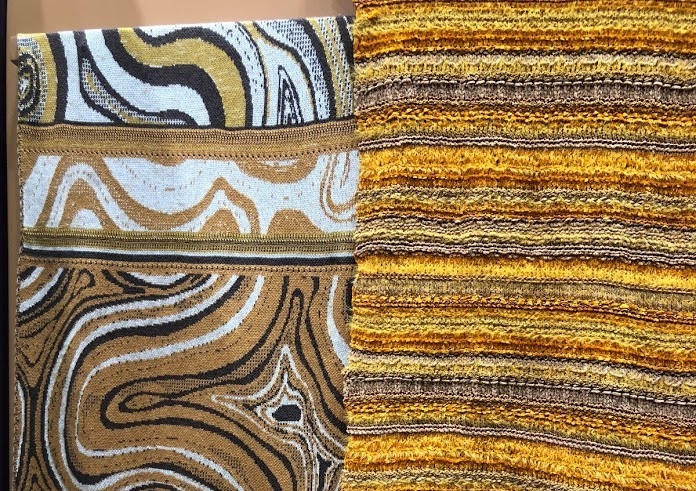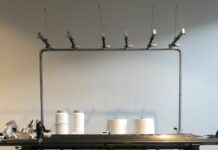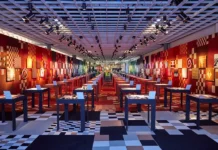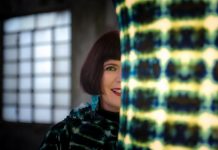Janet Prescott reports from Paris
Knitted fabrics for Autumn/Winter 2019/20 gave more than a nod to sustainability. A mix of different fibres, weights and constructions, with knit and weave complementing each other, contributed to the cheerful visual in Premiere Vision Paris in September. The trends show the versatility of knit as a medium which responds quickly to technical advances and design.
Although aimed for winter, many jerseys and lightweight knitted fabrics were semi-transparent, like Eusebio’s in the trend area, in small stitch graphic micro designs and very fine yarns. Woollen knitted fabrics tended to be more chunky, substantial designs in large dramatic jacquards and large gauge loops and bouclés in warm ginger and dark red colours. Menswear jackets from knitted fabric are versatile, fit for both work and play, cool for work and casual enough with jeans; trends seen at Pitti Uomo and London Fashion Week so there was an increase in semi-formal knitted fabrics; double-face soft grey wools for coats and jackets, e.g. by Toki Sen-I Japan or Alberto Bardazzi, Italy, some in boiled wools or pin-striped smooth knit fabrics.
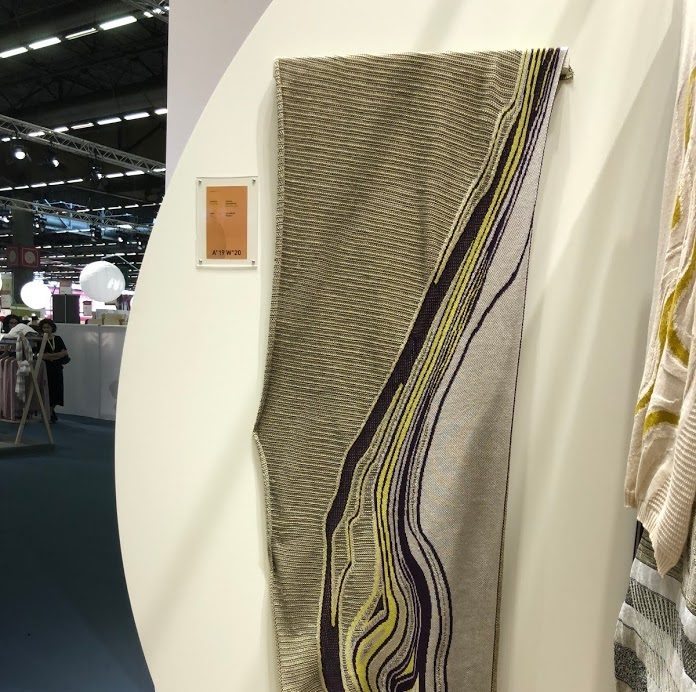
Jersey in cotton, wool, linen or Tencel picked up the comfort trend, sometimes with the addition of luxury elements like angora, cashmere and silk. A trend for jacquards with heraldic looking themes and geometric patterns gave the rich look, teamed with velvets and deep coloured prints.
Paler winter tones, like light turquoise, pink, white were interpreted in jerseys with flammé random effects, as well as soft plains. A slight shimmer came from metallised yarns and small sparkling elements in the yarn.
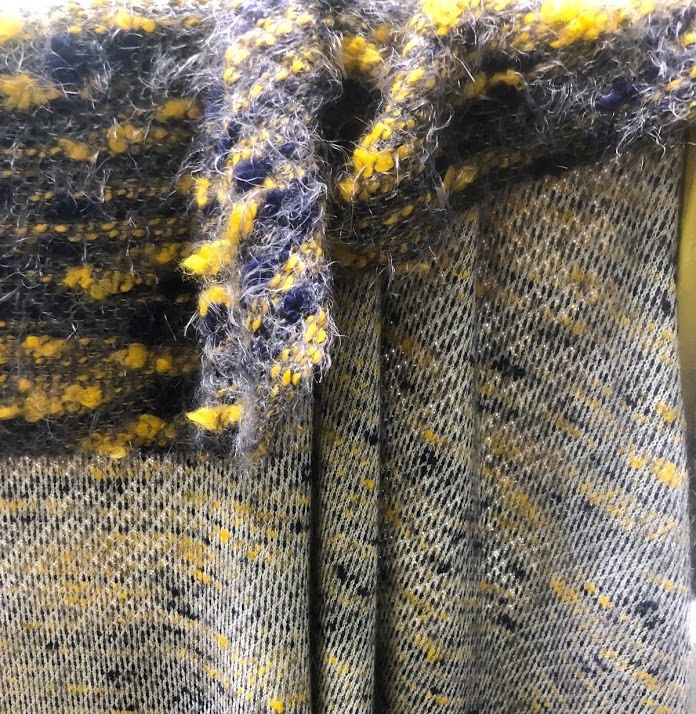
Darker tones of red, brown, yellow and grey contributed to the range of contrasts. Brown is the coming colour – from sludgy eco looks to bright nut shades, bright conker brown, walnuts, hazelnuts, and shiny fabrics from Japanese French and Portuguese knitters. Printed fabrics sported big florals and leaves, many recalling classic Chinese designs, bounteous and florid, immaculately drawn and colourful.
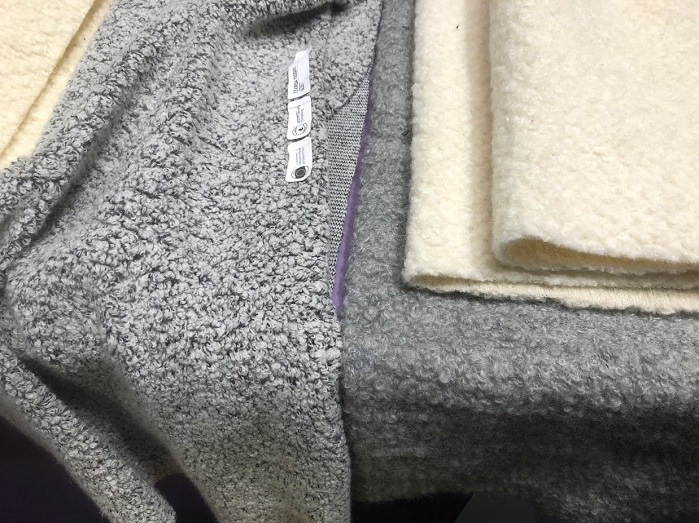
Three dimensional looks were achieved in various ways, by knoppy and textured yarns, and knits of various thicknesses in the same fabric. Digital printing brought optical effects to deceive the eye – woven looks, shimmering surfaces and broken up geometrics.
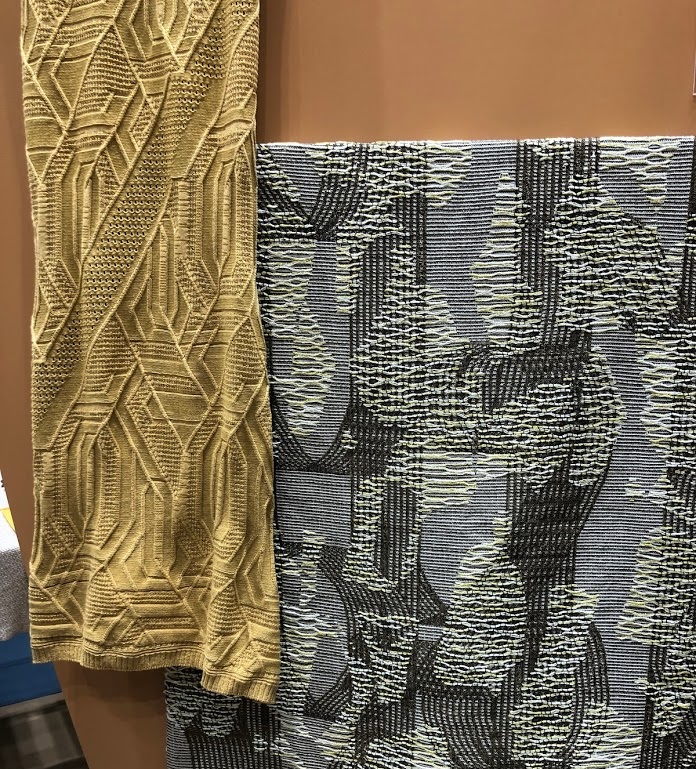
The smart fabric area majored on knit producers and yarn developers with eco and performance to the fore. Bemberg is the new global name for Cupro, the regenerated cellulose fibre, which is produced by treating cotton cellulose with cuprammonium salt. It is, also known as artificial silk. Cupro fabrics breathe like cotton and have a silky feel. Made by Asahi Kasei the international name is now refocused on Bemberg with a new branding for its global market presence. Luxurious jersey feel, and a recent compostable certification see it already used as such by Jackytex, Fianni Crespi Foderami, Lanificio Europa, O’Jersey and Euromaglia, in a long list.
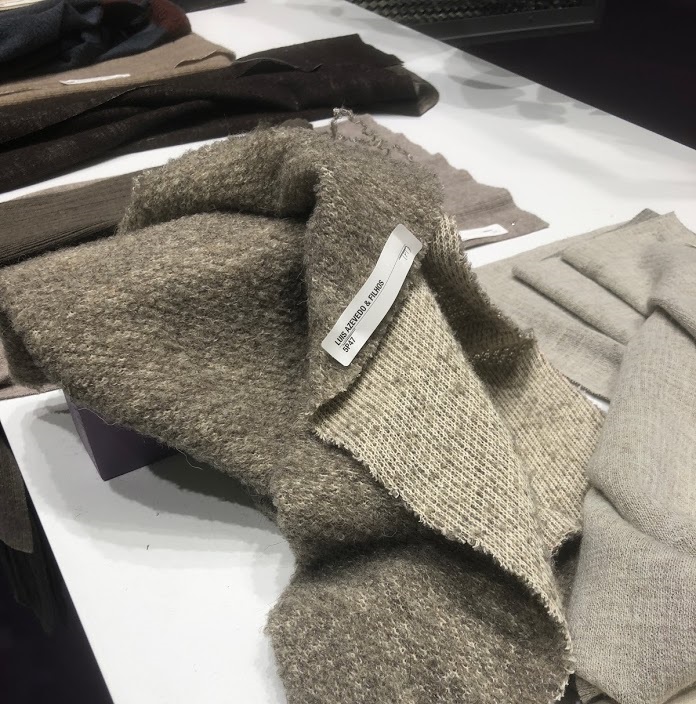
Shima Seiki had a busy stand talking about its Wholegarment Solutions, a subject which is growing interest across the board. High-fashion socks with style on the British UKFT Stand, by KV Manufacturing, are seamlessly knitted in mercerised cotton and 20% polyamide, fine and elegant, and are reputedly already chosen by Paul Smith and high-end brand names.
The athletic/athleisure trend has not lost any impetus. Performance fabrics almost invariably knitted are the cutting edge of development. Anti-allergenic qualities, rigorously tested are increasingly important to sportswear sales, and form part of essential information to the ultimate customer. Yarns with various types of extra comfort and anti-allergenic qualities included examples of athletic vests with pure Merino advanced moisture management presented on the Woolmark stand alongside shoe designs with knitted uppers to bring climate control to running shoes, attracting interest from famous footwear brands.

Comfort is a real issue, with light, relaxed looks taken from track suit looks brought across to urban wear, interpreted in more decorative designs on jersey. Fabrics with performance were decorated with various stickers naming particular advantages bearing the results of advanced technology. These in turn affect the requirements for trimmings, such as knitted tapes, or multicoloured braid which must be used for vigorous wear and demand easy care.
Eurojersey Sensitive Fabrics pride themselves on a systematic eco-conscious production philosophy, for their sporty fabrics with a glamorous edge. They presented a large range of technical fashion fabrics with multi facets, optimising freedom of movement in a Free the Form concept. New digital printing enhances style, with patterns scanned then printed digitally, illustrated in an interesting new fabric made from 73 polyamide /27elastane (carbon footprint of 4.75) soft and semi-transparent, printed with a dense optical pattern echoing a micro weave in dark urban grey.

Smart Creation is a new area of Premiere Vision, with a bigger Smart Square showcasing responsible creation with GOTS certification and many other endorsements, which encouraged buyers to come for information. Sustainable development included pineapple fibre, Ligneah made from vegetable fibre, (there was much talk of vegan fashion) organic cotton dyeing, and examples of cork fabric from sustainable oak in Portugal; Lyocell and Tencel Modal for wood and SeaCell, and Seaqual fibre made from sea-borne plastic into recycled materials
Marchi & Fildi, with Ecotec smart cotton yarns, are now producing for flat knitting for big brands and fast fashion, following on from the original circular knitting developments and are expanding their international client range. New international partners include Avelana, Lurdes Sampaio Knits, NGS Malhas SA and Vilartex.

The launch for womenswear of Naia cellulosic yarn marks the return of acetate to the fashion scene as an eco-fibre, as it is made from wood pulp and produced in a closed loop process. The fibre is certified and marketed as sustainable and used extensively for knit fabrics. It has odour control and a cool touch. Fashion take-up includes fashion-makers Uniqlo, Handel & Diller knit velours, Sofileta textiles and it is blended with Tencel, viscose and polyester among others. The Naia booth included recycled copper piping and mannequins made from recycled cardboard, symbolising 2018’s exhibitor commitment.

Subscribe To Our Newsletter
Join our mailing list to receive the latest news and updates from our team.


